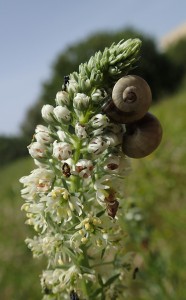Having thought quite a lot about pollinating insects recently (see ‘Why are flowers pretty?’) One thing that surprised me on holiday in Malta last week was the range of plants I saw being pollinated by the same beetle. From Euphorbia dendroides (Tree spurge) in the Argotti Botanic Gardens to all manner of wild flowering plants – Compositae, legumes, lilies and umbellifers – we seemed to see these white-spotted black beetles, fringed with hairs, with their heads in flowers everywhere. Yellow pollen was clearly visible trapped in the hairs on their sides and backs and must be transported freely between the plants they visit. However the beetles appear to be quite promiscuous in what they choose to visit – there is clearly no special relationship with a particular type of flower here.
A little Googling soon showed that our beetle is a White spotted rose beetle (Oxythyrea funesta) and is actually regarded as a pest in most of Europe. Not only do these beetles eat pollen, they also happily munch their way through other flower parts. The balance between costs and benefits seems to lie firmly in favour of the beetle – the plant may be lucky enough to receive pollen from, or have its pollen transferred to, another of plant of the same species just by chance but it may equally lose a large part of its flower in the process. The beetle is not just after the plant’s standard nectar reward but will eat the petals, stamens and stigmas too!
Of course most of the plants on which we saw O. funesta have no particular economic value but the beetle also attacks grapevines in flower, spring blossoming fruit trees and wheat plants. Damage is usually limited in orchards, for example, by using funnel traps baited with volatile organic compounds which mimic those released by flowers. This way, the use of insecticides which would harm bees and other beneficial insects can be avoided. It also helps if the funnels are fluorescent yellow, apparently, though on the evidence of my photos fluorescent pink might be equally effective! Though the beetles are widespread in continental Europe, their range does not extend as far east as India so I don’t suppose we will see these particular scarab beetles in Kashmir or Ladakh come June.
Of course this begs the question of what other animals which hang around plants are actually doing; snails on White mignonette (Reseda alba) in this case….
The evidence suggests that snails as pollinators are rare indeed – most likely this pair are just enjoying an afternoon snack!




[…] space (and an excellent bus service, with day tickets costing just 1.50 Euros). Somewhere, on a blog not very far away, someone might even be writing about some of these […]
These white spotted rose beetles (oxythyrea funesta) aren’t particularly pollinators, they consume the flower, pollen, petals etc. and make a hideous mess throughout the garden, I can’t post pictures on your post but I have photos of the horrendous damage they did last hear in the garden we work in. These ones are definitely not good guys.